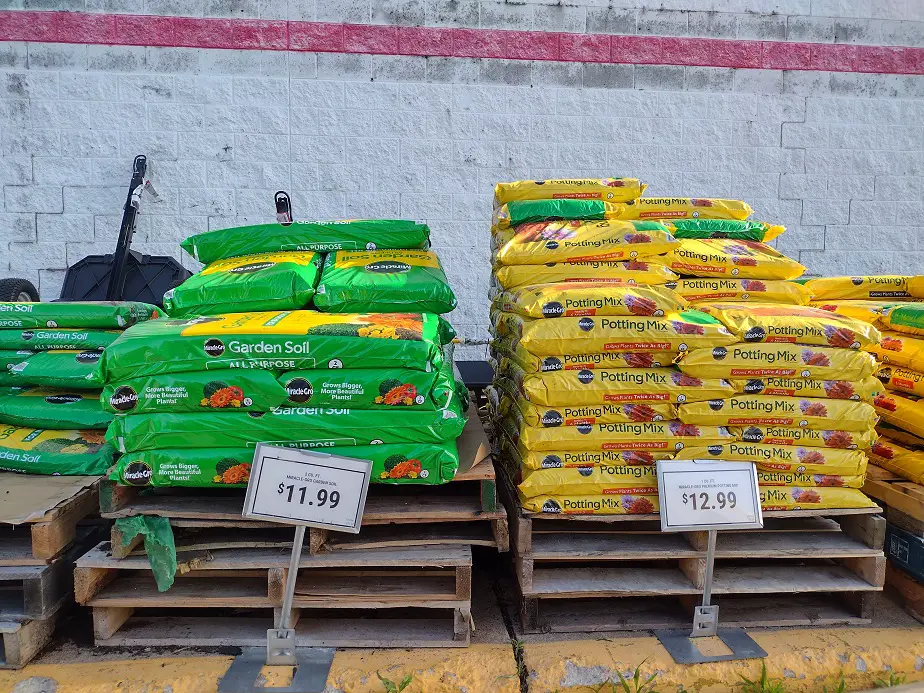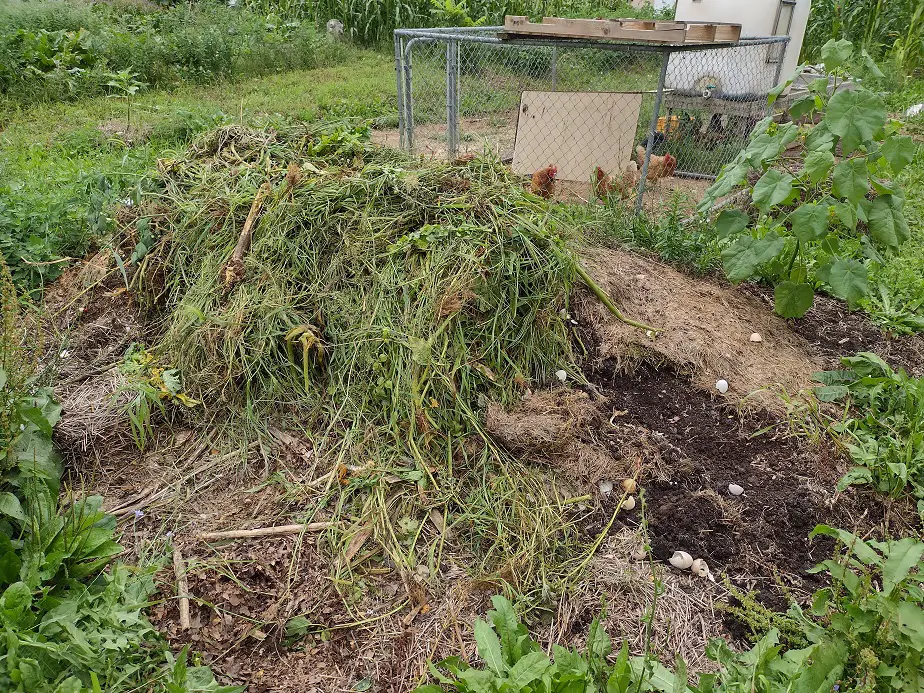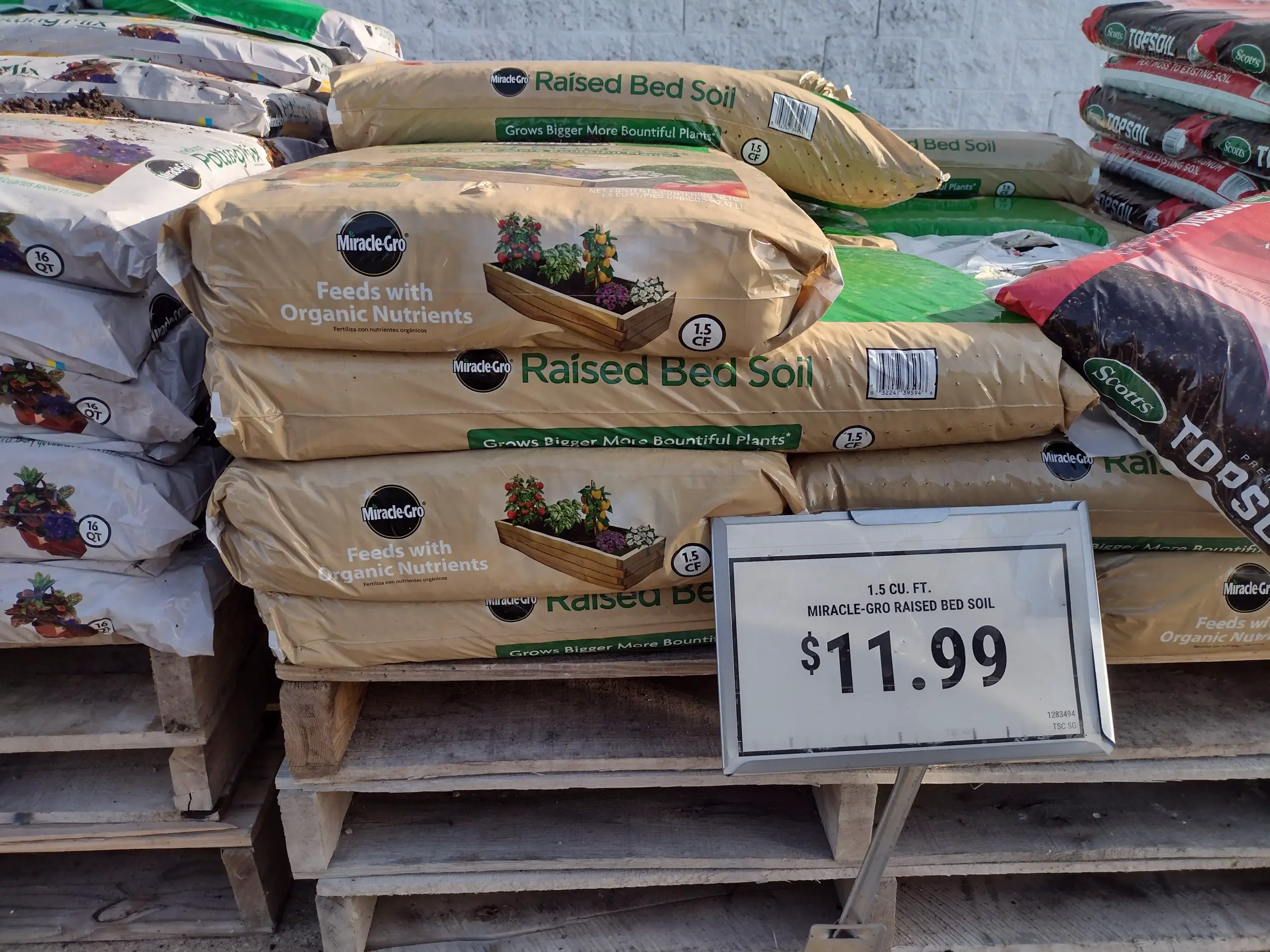I’ve been gardening for a long time, but all the soil options still confuse me. Let’s clear up some here.
Raised bed soil is a medium-weight, compost-rich soil with good drainage that will feed plants, but not get too waterlogged. Raised bed soil generally has extra added fertility to feed plants. Its most important factors are good drainage and high organic matter.
Raised beds are getting popular, but what do you want to fill them with? What do you really need?
What’s so Special About Raised Bed Soil?
Raised bed gardening comes with two primary concerns and both of them stem from the fact that even though they can be large, raised beds are still containers. Because they have a limited amount of soil, raised beds can get too soggy and kill off a plant’s roots.
Many raised beds have really good drainage, but it’s never as good as a good in-ground garden. The side walls keep water in, and if you have a bottom to your bed, that really keeps the water in. Don’t use a raised bed with any type of solid-ish bottom. That’s a good way to make a swamp.
The second issue is limited plant nutrients. In nature, soil fertility leaches from where it is to where plants are. Water within the soil carries nutrients around, and worms bring fertile matter from one spot to another. That doesn’t happen nearly as much in a raised bed. So, it needs to be extra fertile.
Raised bed soil is generally fairly heavy compared to potting soils, but not as heavy as garden soil or topsoil. Raised bed soil is what I would call medium-weight soil. Usually near half heavy material (compost) and half fluffy stuff (peat moss, shredded bark, or coconut husk fiber).
It can and often does have perlite or vermiculite in it to improve its water-storing abilities, but those are not needed. I consider them unnecessary extras. The important thing is compost, and if drainage is a concern for you, something to help the drainage.

How to Improve the Drainage in a Raised Bed
Raised beds can have improved drainage by making them taller or by adding larger particles, like coarse sand, shredded bark, and peat moss. It’s not always necessary, but if you are experiencing problems, try adding something with more texture to your raised beds so water will flow through.
Dire circumstances call for dire measures. Don’t let your bed turn into a bog. Hey, It happens. But, if it’s getting worse, find a way to correct it. If you notice the soil is really wet and just not drying out, It probably needs something done. Be sure and dig around in your garden now and then to check.
I really like to use a pure compost mix in raised beds because it’s just so amazing and naturally fertile, and it really holds on to nutrients so well. But, in some types of beds and in some areas, that’s just not gonna work. Compost doesn’t usually drain well on its own. It gets fairly mucky.
If your soi beneath is not well-drained; if it often has pooling water or is a bit swampy, you better add some extra drainage to your bed. If you live in a place that gets a lot of rain (Juneau Alaska comes to mind), you’re going to need extra-draining soil. Very few plants are okay with constantly wet roots.
Plants need air for their roots (because they actually take in air too). Soil needs to have good air or the good bacteria die off and bad bacteria increase. So please, consider the drainage of your soil. Maybe run a check on it just to be sure.
Let the hose run on low for several hours, then check on things the next day to see if it’s mostly drained, or if the soil is holding water like a marsh or swamp. It should be wet, but not soggy.
Mixing Your Own Raised Bed Soil
An even mix of composted manure and peat moss is one of the best and cheapest homemade raised bed soils. A cheaper option is mixing two-part dirt, one part composted manure and one part peat moss. It’s not ideal or super fertile, but will probably work if you monitor the soil fertility and drainage.
I have made my own soil mixes and brought soil mixes enough to have some data to compare. I’ve done several different mixes. One of my favorites is the 50:50 compost/peat moss mix. I’m also a fan of pure compost in some instances. But that can be hard to manage.
This year, one of my best mixes was a special custom Jordy’s own blend. I dug up the dirt from where my rabbit cages were last year (it was super fertile and was full of mostly composted rabbit manure) and mixed it 50:50 by volume with fluffed-up peat moss.
That stuff is working incredibly in a planter box and in 3 and 5-gallon pots. pots that big are closer to raised beds than smaller pots. I have some of the best-looking plants I have ever seen growing in them! I’m thrilled. It’s okay to be creative and clever, and use what you have at hand.
There’s really no hard-fast rule about “use exactly this or that” for garden soil. You may not have money for expensive soil, but that’s fine. Can you get a few wheelbarrows of dirt from somewhere and buy a $10 bag of compressed peat moss?
Maybe you don’t have super fertile, rich black dirt. But, do you have grass clippings that you can add in to boost organic matter? Maybe you can get your hands on a few bags of fallen leaves, or some manure from a farm.
Even just composting your kitchen waste will create enough organic matter to really boost up less desirable soil. Because raised beds are small (compared to an in-ground garden), the soil can be quickly and easily changed to make it work better for you. Make gardening work for you where you are.

Can Other Soil Mixes Work?
You can use potting soil or garden soil in a raised bed if that’s what you have, but you should mix other things in it to balance it out. Garden soil is compost-heavy and benefits from adding peat moss. Potting soil is very fluffy and will need topsoil and/or compost added to make it suitable for raised beds.
Best Soil Mix for Raised Beds
The best raised bed soil is often a home-brewed mix of peat moss and compost, with organic amendments. But, Miracle Grow Raised Bed Soil is the most popular. Bulk topsoil is also quite common for larger beds, but it should be amended with compost to increase its nutrient-holding capacity.
I’m personally not the biggest fan of regular old Miracle-Grow because I try to stay organic. Plus, Miracle Grow is under Scotts, which is part of Monsanto, and Monsanto is now owned by Bayer. Both Bayer and Monsanto have had some pretty shady dealings, so I prefer to stay clear of them.
I’ve bought the off-brand soil mix from Lowes and Home Depot. It works alright and it’s a bit cheaper. I do really prefer to mix my own. My rabbit manure mix, holy cow, it works wonders. I’m always on the lookout for new things to try and did something different this year that didn’t quite work out.
I saw a local farmer advertising “high-quality compost” for $20/yard. That’s a heck of a deal. I bought 10 yards and gave him a fifty to deliver it. The compost was supposed to be fully composted dairy manure from his milk barn. Well, it wasn’t quite composted.
About half of it was course sawdust, which isn’t bad itself, but the sawdust wasn’t broken down well. That stuff takes longer than cow poop. Well, I filled a new raised bed with it and it didn’t do so great. Basically, it wasn’t finished compost yet. It was halfway compost. It is getting better throughout the season though.
Quality compost tends to sell for around $80/yard, so finding it cheap was more important to me than getting the best stuff. I can get lesser stuff and make it high-quality. If you don’t have a farmer nearby who will sell you compost, Home Depot often sells locally made, bulk compost online, and the price isn’t bad.

How to Fill a Raised Bed Garden Cheaply
Buying cheap bulk compost, using your own soil, and making your own compost are the best ways to cheaply fill a raised bed. In a deeper bad, the lower half can be filled with organic materials like leaves, sticks, and grass clippings to lower the amount of soil you need to purchase.
Besides buying compost, you can also buy hay, straw, or manure from a farm. All of those will benefit from a raised bed. even fresh manure can be used to fill up the lower portion of a raised bed or can be mixed into your raised bed soil. I check Facebook marketplace for manures and composts regularly.
Often, you can get it pretty cheap. If you want a bed several feet deep, I would consider using bales of hay or straw on the bottom, and filling the rest with dirt. The hay or straw will break down nicely, and really boost up your soil. But, as it breaks down, the soil level will get lower and will need topping off.
Grass clippings and leaves are my favorite soil amendments, and make a superb compost together. You can use them to partially fill a raised bed, or pile them up and let them decompose first. If you use a lawnmower to mulch the leaves, they will break down faster.
I wrote a more in-depth article on filling raised beds cheaply. Here’s the link: 10 Things to Put in a Raised Bed
Related Articles:

